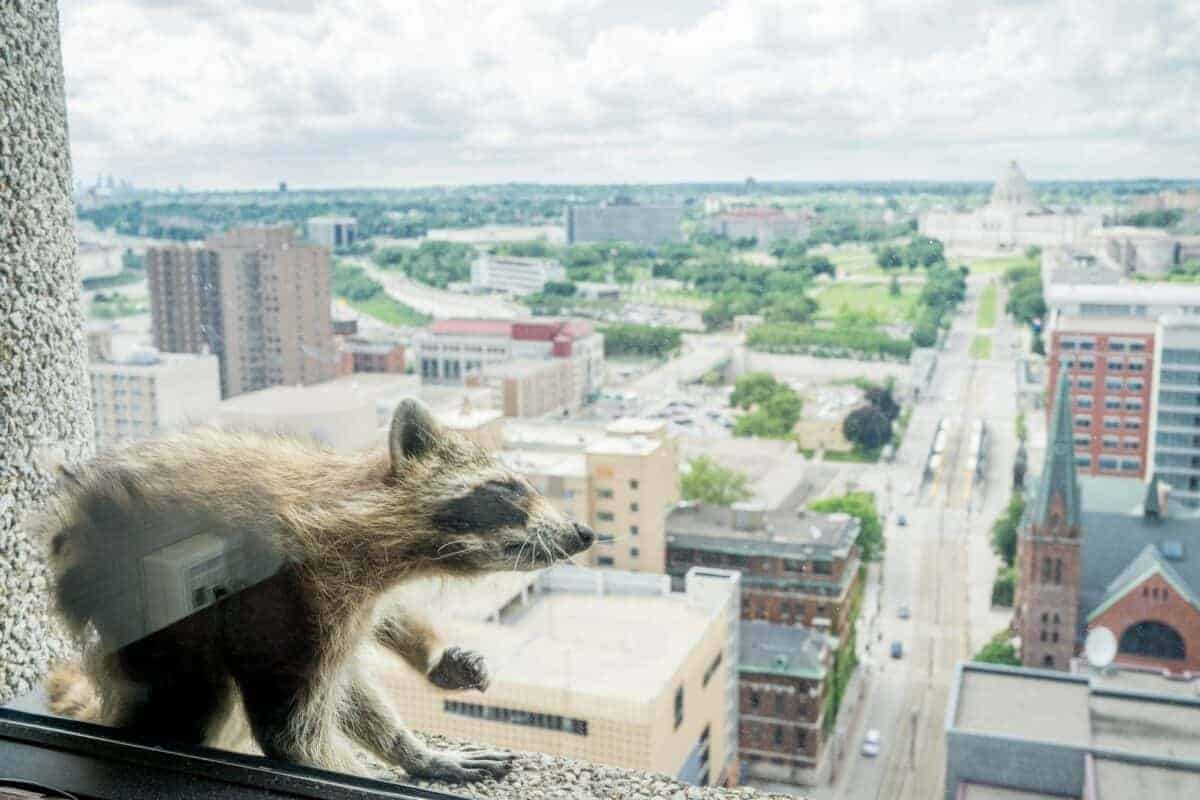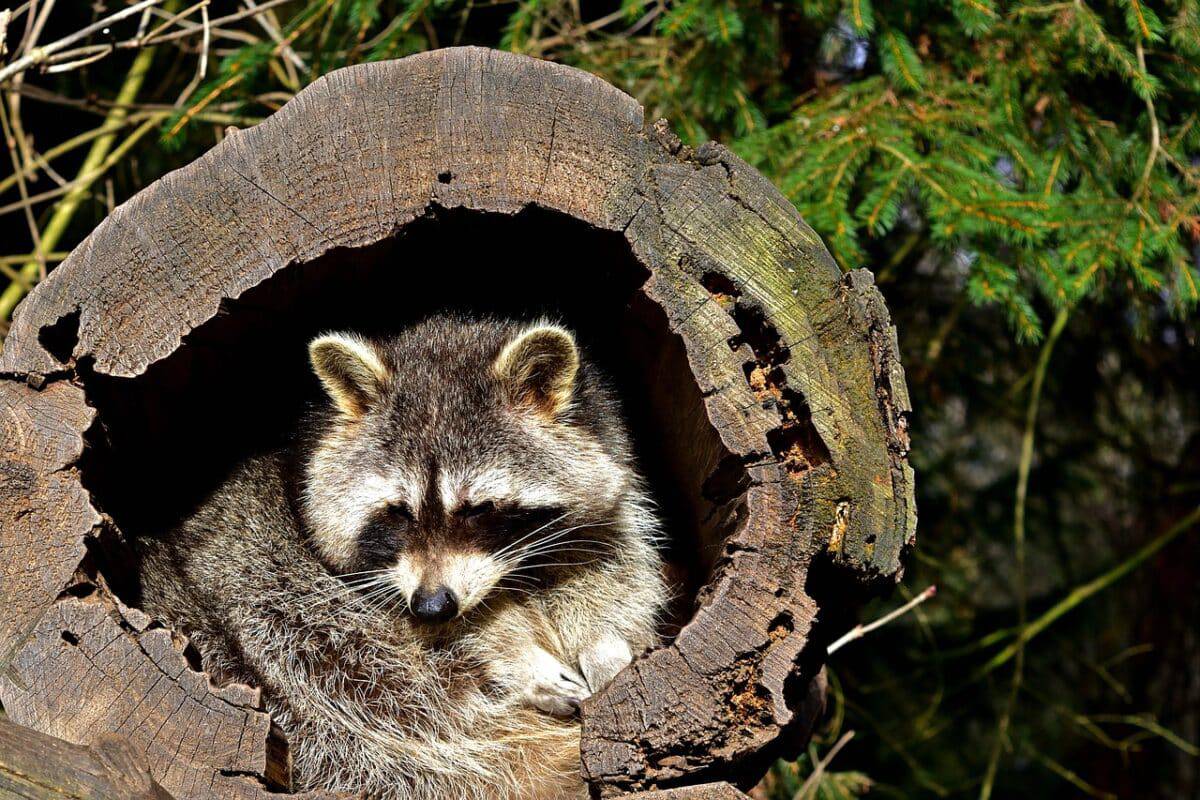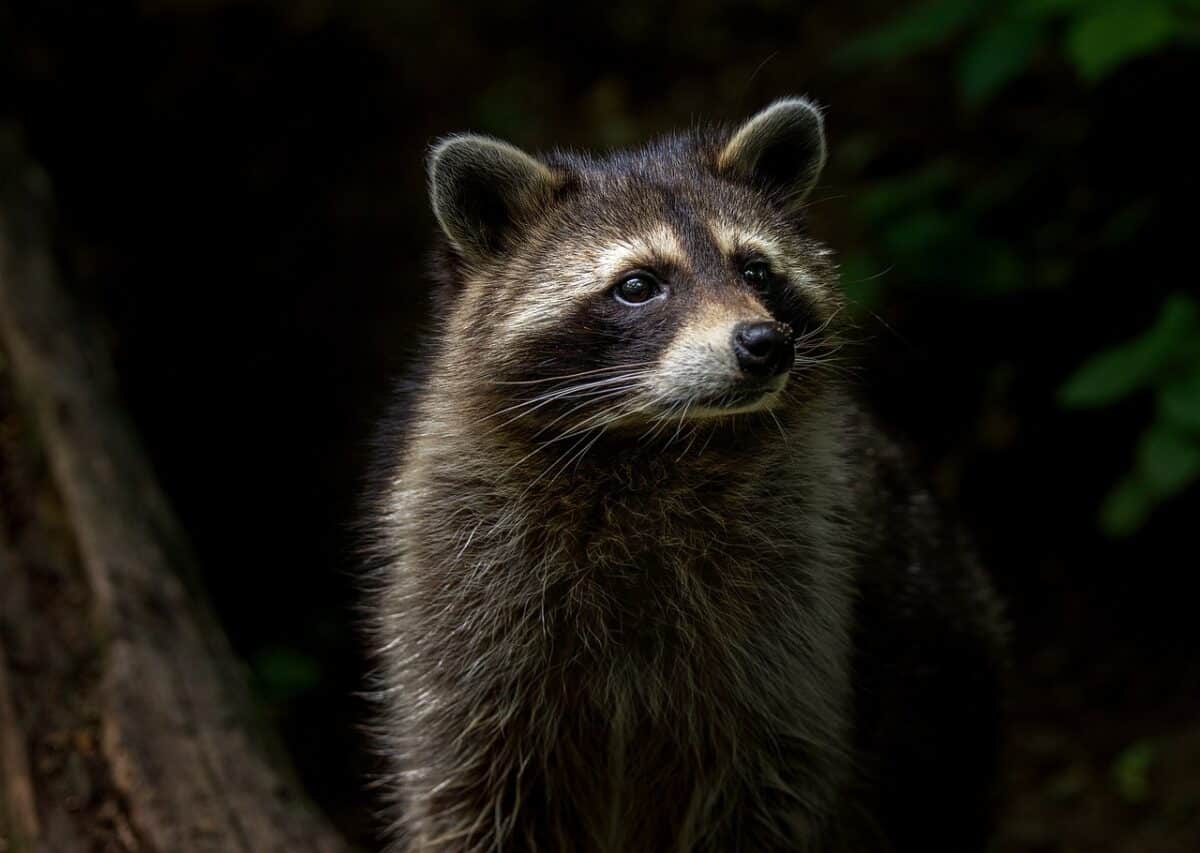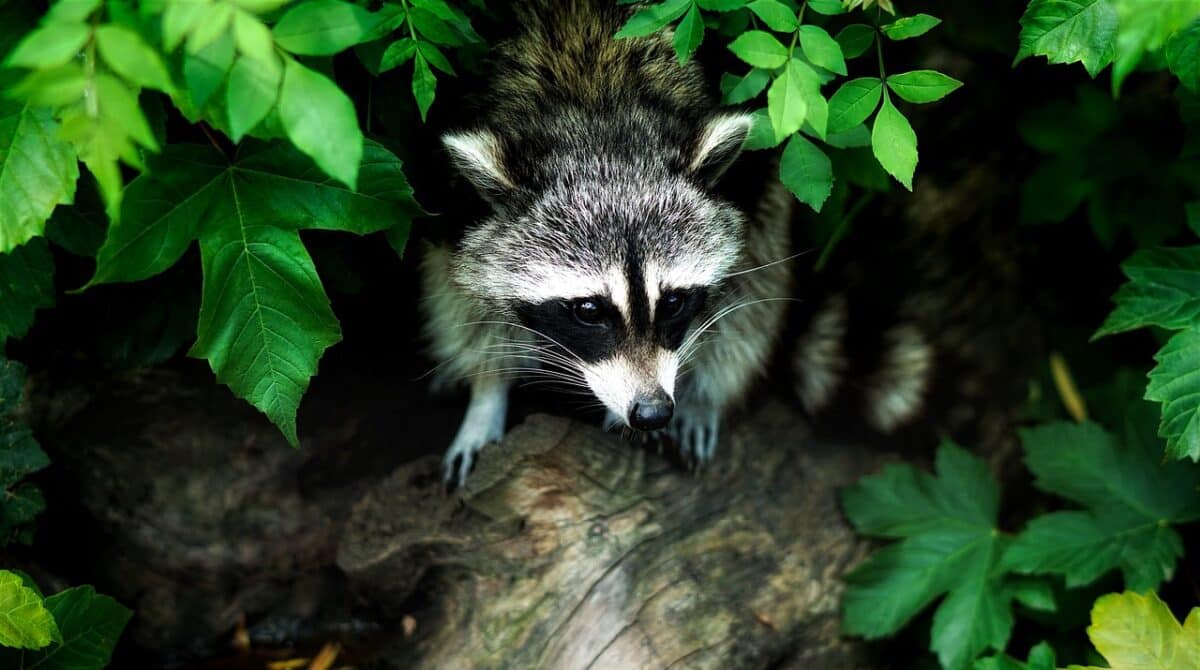One brave raccoon was seen scaling a skyscraper in 2018 – let’s take a closer look at this incident and this intelligent creature.

Raccoons have long fascinated nature enthusiasts and city dwellers with their cleverness and adaptability. These medium-sized mammals, known for their distinctive black mask and ringed tail, possess unique skills that allow them to thrive in diverse environments.
However, in recent years, one raccoon captured the world’s attention by showcasing its exceptional climbing abilities on an unlikely stage—a skyscraper. In June 2018, a raccoon in St. Paul, Minnesota, embarked on a daring ascent up the UBS Plaza, a 25-story office building.
This audacious feat mesmerized onlookers and ignited a social media frenzy, with people anxiously following the raccoon’s progress and rooting for its successful climb. The event served as a beautiful reminder of the raccoon’s innate ability to conquer urban landscapes and adapt to the challenges they present.
In this article, we delve into the incredible story of the raccoon scaling a skyscraper, exploring the phenomenon and shedding light on the remarkable characteristics of raccoons.
Key Points
- Raccoons are clever and adaptable mammals known for their distinctive appearance and survival skills.
- A raccoon’s daring ascent up a skyscraper in St. Paul captivated the world, showcasing its remarkable climbing abilities.
- During the climb, the raccoon’s tenacity and agility mesmerized onlookers and sparked a social media frenzy.
- Raccoons possess unique physical characteristics, including dexterous paws, sharp claws, and flexible joints, enabling their exceptional climbing abilities.
- Raccoons are intelligent creatures, exhibiting curiosity, problem-solving skills, and adaptability to urban environments.
An Overview of the Raccoon

| Trait | |
|---|---|
| Length | 16 to 28 inches |
| Weight | 8 to 20 pounds |
| Diet | Omnivorous – eats fruits, nuts, insects, and small animals |
| Habitat | Forests, wetlands, urban areas |
| Geographic Range | Native to North America |
| Conservation Status | Least Concern |
| Lifespan | 2 to 3 years in the wild, up to 20 years in captivity |
The Raccoon Found Scaling a Skyscraper
The raccoon’s impressive skyscraper climbing adventure in St. Paul, Minnesota, unfolded over several days, captivating the world with each nimble maneuver it executed. The saga began when the raccoon was spotted on a lower ledge of the UBS Plaza, drawing immediate attention from onlookers and local media.
As the raccoon ascended higher and higher, its daring journey sparked a wave of public interest and concern. People took to social media platforms, sharing photos and videos of the raccoon’s progress and expressing admiration and concern for its safety. The hashtag #MPRraccoon began trending on Twitter, transforming the raccoon into an overnight celebrity.
What made this raccoon’s climb so astonishing was not only the height of the building but also the sheer determination it displayed. Raccoons are well known for their climbing abilities, thanks to their sharp claws, strong limbs, and flexible joints. Their paws, resembling tiny hands, provide them with excellent talent, allowing them to grip and manipulate objects easily.
Its tenacity and agility were on full display throughout the raccoon’s ascent. It scaled walls, navigated narrow ledges, and effortlessly traversed challenging obstacles.
As spectators held their breath, the raccoon conquered each daunting stretch with apparent confidence, captivating the world with its fearless spirit.
Understanding Raccoons

Raccoons, scientifically known as Procyon lotor, are native to North America and are renowned for their adaptability and resourcefulness. That’s how they keep surprising us with their incredible acrobatics and innovative solutions!
Let’s take a more in-depth look at this fascinating species:
Physical Characteristics and Adaptations
Raccoons possess unique physical characteristics and adaptations that contribute to their remarkable climbing abilities.
These medium-sized mammals have a stocky build, ranging from 16 to 28 inches long, excluding their bushy tails. Their bodies are covered in dense fur, which provides insulation and protection.
Here are a few other physical descriptors to help you characterize them:
- Claws and Limbs: Raccoons’ front paws are highly dexterous, resembling tiny hands, with five long and curved claws. These sharp claws allow them to grip and manipulate objects with precision.
- Flexibility and Joints: One of the key factors contributing to raccoons’ agility is their flexibility. They have a wide range of motion in their limbs, particularly their hind legs, which allows them to navigate complex environments. Their joints are designed to be flexible, enabling them to contort their bodies and adapt to various climbing surfaces.
Behavior and Intelligence
Raccoons are known for their inquisitive nature and problem-solving abilities. Their intelligence is evident in their ability to adapt to changing environments and seek new food sources.
These adaptable creatures’ cognitive skills contribute to their survival in natural and urban habitats.
- Curiosity and Exploration: Raccoons are curious, often investigating their surroundings and manipulating objects to uncover potential food sources. Their dexterous paws enable them to open containers, dismantle structures, and solve simple puzzles. This behavior allows them to exploit opportunities for sustenance in urban settings.
- Problem-Solving Skills: Raccoons demonstrate problem-solving abilities when faced with challenges. They can assess their environment, identify potential obstacles, and find creative solutions. For example, they may find alternative routes or use their paws and claws to grip and navigate complex structures.
Adaptability to Urban Environments
Raccoons have remarkably adapted to urban environments, including skyscrapers and other manufactured structures. The availability of food resources, such as garbage bins and discarded human food, attracts raccoons to cities and suburban areas. Skyscrapers, with their intricate architectural features and potential nesting sites, offer raccoons additional opportunities.
- Urban Diet: Raccoons are versatile and can opportunistically feed on various food sources. In urban environments, they scavenge for discarded food, raid trash cans, and exploit human settlements for sustenance.
- Nesting and Shelter: Skyscrapers offer raccoons potential nesting sites and sheltered areas for raising their young. Attics, chimneys, and other elevated spaces provide them with safe and secure locations away from predators.
While raccoons’ adaptation to urban environments is impressive, it is essential to manage their presence responsibly to avoid conflicts with humans. Implementing measures such as securing garbage cans, eliminating attractants, and sealing off potential entry points to buildings can help mitigate unwanted interactions.
Read an even more comprehensive look at this talented creature here.
Raccoons and Urban Environments

Raccoons have become increasingly adept at thriving in urban environments. The abundant food sources, such as garbage bins and discarded human food, have drawn raccoons to cities and suburban areas. With their complex architectural features and potential nesting opportunities, Skyscrapers and other buildings with plenty of scaffolding are particularly enticing to these clever mammals.
While raccoons’ ability to adapt to urban settings may be impressive, they pose challenges. Their proximity to humans can result in conflicts, such as scavenging in trash cans and raiding gardens. Furthermore, their nesting in attics or chimneys can cause property damage.
To mitigate these issues and promote peaceful coexistence, it is essential to understand raccoons’ behavior and implement preventive measures. These include:
- Securing garbage cans
- Eliminating potential food sources
- Sealing off access points to buildings
- Deter raccoons from venturing into unwanted areas
It is important to remember that raccoons are wild animals and should be appreciated from a safe distance.
Raising Awareness and Coexistence

The raccoon scaling a skyscraper incident is a valuable opportunity to raise awareness about urban wildlife and the importance of coexistence. Understanding raccoons’ natural behaviors and implementing responsible practices can foster a harmonious relationship with these captivating creatures.
Educational initiatives play a vital role in informing the public about raccoon behavior and the need for conservation efforts. Teaching communities about proper waste management, including secure trash disposal and composting, helps reduce attractants that entice raccoons into urban areas.
Furthermore, supporting wildlife rehabilitation centers and conservation organizations dedicated to protecting raccoons and their habitats can make a meaningful impact. These organizations often provide valuable resources, such as educational programs and community outreach, to promote understanding and appreciation for wildlife.
Together, we can ensure that future raccoons and other urban wildlife continue to inspire awe and wonder in the hearts of city dwellers.
Learn more about a raccoon’s Dunkin’ Donuts adventure here.
A Raccoon Scaling a Skyscraper: The Bottom Line
The raccoon scaling a skyscraper incident captured the world’s attention, showcasing these fascinating creatures’ adaptability and natural climbing skills. With their intelligence, physical prowess, and resourcefulness, Raccoons are well-suited for urban environments, including the challenges of towering skyscrapers.
As we navigate the coexistence of humans and wildlife, we must appreciate raccoons’ unique characteristics and understand the importance of responsible practices.
By securing potential food sources, implementing preventive measures, and supporting conservation efforts, we can create spaces where raccoons and other urban wildlife can thrive without causing conflict.
Let us celebrate the raccoon’s remarkable climbing adventure as a reminder of the incredible adaptability of nature and our responsibility to protect and respect the wildlife that shares our urban landscapes.
Thank you for reading this article! Keep exploring the breaking news of the animal kingdom and read about this deer that eats a snake, a blood-splattered pilot after a giant bird collision, or a horrifying canine incident in Central Park.
Join our Forum for free today!



